#giant water bug
Explore tagged Tumblr posts
Text

Meanwhile, in the bayou...
Thank you to @bittermelonfarmer for commissioning this piece!
3K notes
·
View notes
Note
Are you able to identify the bug from the weird bug in charge of the night time meme?
I can't say which exact species, but it's a giant water bug in the family Belostomatidae - they're often called toe biters. I imagine if you found the original photo that was pasted into the meme, it would tell you the exact species, if you care.
I assume everyone's seen it, but if not:
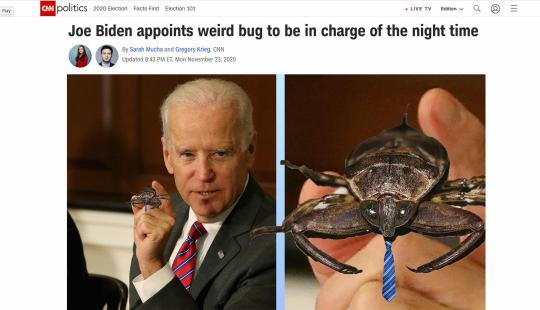
3K notes
·
View notes
Text

My newest tattoo I got as a birthday gift. It's a giant water bug holding a wishing star. It's beautiful and means so much to me! I'm calling him King Wisher.
Done by ozzybat.ink on instagram!!!
170 notes
·
View notes
Text
Wet Beast Wednesday: true water bugs
A while back, I made a Wet Beast Wednesday post about aquatic insect larvae. In that post, I said I'd do another one on aquatic adult insects. Well the time has come, but there are too many aquatic insects to do a whole post about. Instead I decided to cover one group of them, the true water bugs of the clade Nepomorpha. These are all members of the true bug order Hemiptera notable for their aquatic lifestyles, though some spend much of their time on shore and a few species can even fly. Like the larvae post, I'll split this up into brief overviews of some notable groups.
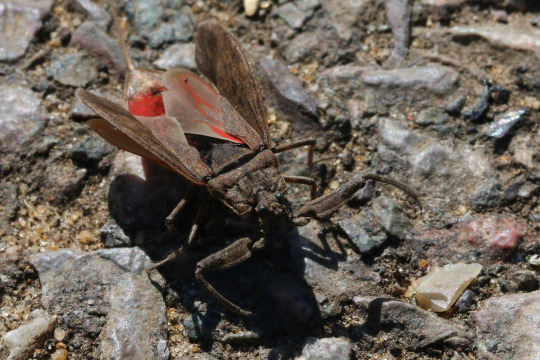
(Image: the water scorpion Nepa Cinerea in a threat posture. It is a large, brown, beetle-like insect. The front pair of legs are developed into mantis-like grasping limbs. The wings are spread, revealing a red abdomen. A tube-like tail extends from the rear end. End ID)
Probably the most famous of the Nepomorpha are the giant water bugs of family Belostomatidae. Also known as toe-biters, alligator ticks, and electric light bugs, these bugs are know for their extremely painful bites. Like other Nepomorphs, their mouthparts are fused into a proboscis which they use to pierce the hides of their prey. They then releases digestive venom into the prey, causing its insides to liquefy for the bug to suck back up. The bites of giant water bugs are described as being excruciatingly painful, but are not medically significant. Giant water bugs look similar to beetles, but their front pair of legs are modified into grasping claws that are used to grab prey and hold it still. In insects, grasping limbs like this are called raptorial. They are primarily ambush predators and their prey includes other invertebrates as well as small fish and amphibians. The largest species are in the genus Lethocerus, which are large enough to hunt young turtles and snakes. The largest can reach over 12 cm (4.7 in), making them the largest of the true bugs. Members of Lethocerus are also powerful flyers known to congregate around electric lights during mating season. After mating, the female lays her eggs on the male's back. He will protect them until they hatch, though he is rendered flightless during this period and cannot mate again until they hatch. Females will mate many times each season. The species Lethocerus indicus is often eaten fried in southeast Asia.
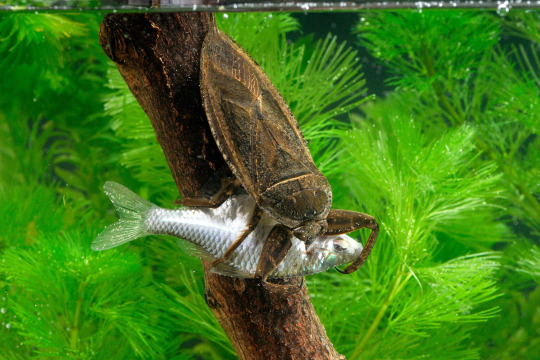
(Image: a giant water bug standing on a stick just below the surface of the water. It is a large, brown, beetle-like bug with a distinct head and large eyes. The front legs are adapted into grasping claws. It has grabbed a small, silvery fish and is feeding on it. End ID)
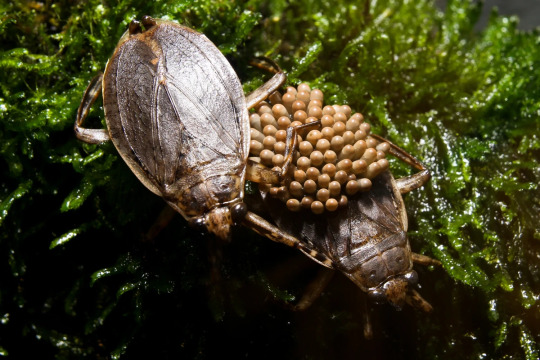
(Image: a female and male giant water bug having recently mated. They are visually similar, but the male is carrying eggs on his back. They are light brown, oval structures laid in a large cluster. End ID)
Similar in appearance and lifestyle to the giant water bugs are the much smaller creeping water bugs of family Naucoridae. While their lifestyle as sit-and-wait predators who use raptorial front legs to catch prey and a proboscis to inject digestive venom is very similar to that of the giant water bugs, they max out in size at about 1.3 cm (1/2 in). Despite being much smaller than giant water bugs, their bites are reported to be far more painful, among the most painful of insect bites, though still not medically serious. They trap bubbles of air beneath their wings to bring an air supply with them as they dive.
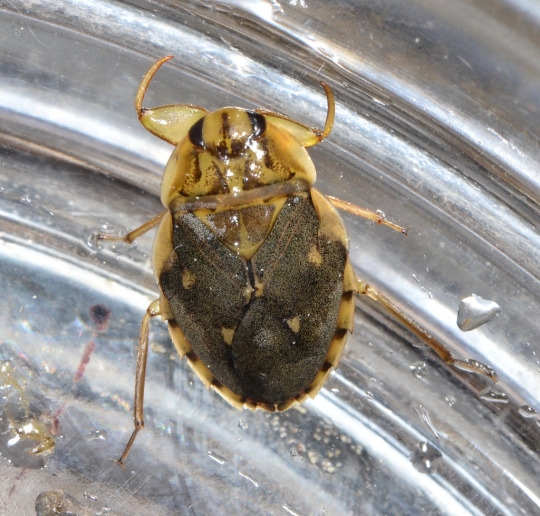
(Image: a creeping water bug. It resembles a giant water bug but with shorter limbs and a less distinct head. Its body is yellowish with darker brown patched and dark wings folded over its body. End ID)
Water scorpions are members of the family Nepidae. All true water bugs have a tube-like structure on their rear ends called the siphon that is used to intake air from the surface of the water. The Nepinae have siphons that are much longer than those of other true water bugs which, combined with their raptorial front limbs, has given them the nickname water scorpions. The water scorpions are divided into two subfamilies, Nepinae and Ranatrinae. The Nepinae have rounded bodies that make them look very similar to giant water bugs while the more common Ranatrinae have slender, elongated bodies that make them look more like stick insects. Water scorpions lay their eggs in mud of vegetation near the water line and prefer slow moving or still water habitats. The family is highly adaptable and has species adapted to hypersaline salt lakes and brackish waters as well as an eyeless, cave-dwelling species found in hypoxic water in Movile cave, Romania. Water scorpions are predators that target invertebrates, tadpoles, and small fish. Their bites are painful to humans, but not dangerous.
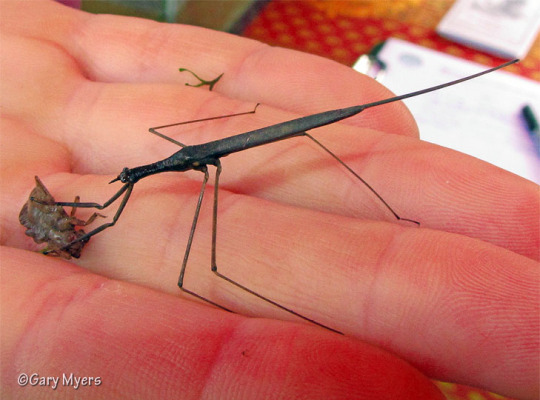
(Image: a Ranatrinid water scorpion held on someone's hand. It is a very long, skinny insect with long, slender legs and forelimbs adapted into raptorial claws. A long-strait tail almost as long as the body emerged from its back. Its grabbing limbs are interacting with another, smaller insect. End ID)
Some true water bugs with a disputed taxonomy are the backswimmers, pygmy backswimmers, and Helotrephids. Typically, backswimmers are placed in the family Notonectidae while the other two are in the family Pleoidea, but some taxonomists argue they should all be in the same family. Backswimmers and pygmy backswimmers have similar body plans and lifestyles, with size being the main difference between them. Both are beetle-like bugs that swim with their bellies facing up. The hind pair of legs is longer than the first two pairs and hairy, allowing them to be used as paddles when swimming. Unlike many other water bugs, which primarily crawl around their habitats and act as ambush predators, backswimmers are powerful swimmers who actively hunt prey as large as tadpoles and small fish. Their front limbs are raptorial and they are capable of flight. Pygmy backswimmers similarly swim upside down and hunt prey, tiny invertebrates in their case. Both groups also have a soft part on their abdomens they use to store air bubbles, which can be refreshed by a trip to the surface. Helotrephids are a sister group to the pygmy backswimmers and are less adapted to swimming, instead crawling for most of the time. Backswimmers can deliver a painful but non-dangerous bite to humans while both pygmy backswimmers and Helotrephids are too small to pierce human skin with their proboscises.
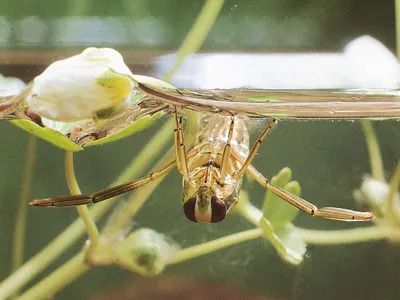
(Image: a backswimmer using surface tension to cling to the surface of the water. It is an insect whose back legs are much longer than the others and have hairy, paddle-like tips used for swimming. It is light brown and has large eyes. end ID)
Similar in appearance to backswimmers are the water boatmen and pygmy water boatmen of families Corixidae and Micronectidae (pygmy water boatmen were formerly classified as also being in Corixidae). The easiest way to tell water boatmen and backswimmers apart is to look at their posture while swimming. While backswimmers swim belly-up, water boatmen swim belly-down. Their four back limbs are long and end in scoop-like tarsi that act as paddles while the forelimbs are shorter and hairier and used for swimming instead of the raptorial forelimbs that backswimmers have. Like backswimmers, water boatmen are powerful swimmers that hunt prey. Unlike all other true water bugs, not all water boatmen are predatory. there are omnivorous, detritovorous, and even entirely herbivorous species that feed on algae and aquatic plants. Note that in some places, water boatmen are known as lesser water boatmen while backswimmers are called greater water boatmen.
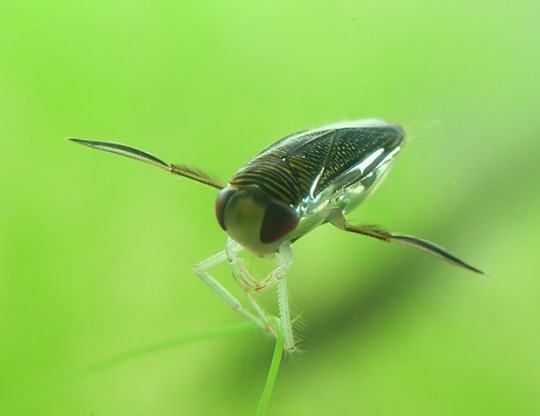
(Image: a water boatman clinging to a green fiber. It is a beetle-like bug with long, hairy back legs and shorter front legs. Its body is brown, with numerous small, yellow stripes along the back. End ID)
Two closely related families of true water bugs that live along the shore rather than in water are the toad bugs of Gelastocoridae and the velvety shore bugs of Ochteridae. Both are named for their appearance, with toad bugs being warty and capable of jumping while the velvet shore bugs are known for the extremely fin hairs some species have that helps keep them dry. Toad bugs are predators of other insects who leap onto prey and hold it down with their raptorial front legs. Velvety shore bugs are believed to hunt similarly and can fly.

(Image: a toad bug held on the tip of someone's finger. It is a small, beetle-like bug with a lumpy back and head and short, grasping forelegs. End ID)
The last well-known of the true water bugs are the closely-related families Aphelocheiridae and Potamocoridae, about which almost nothing is known.
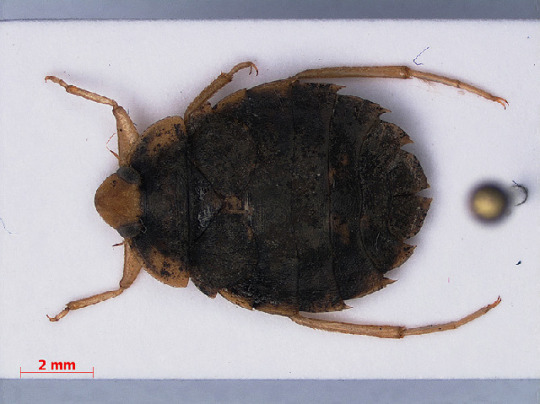
(Image: a member of Aphelocheiridae, a small, beetle-like bug with grasping front legs. End ID)
True water bugs are a very successful group, living in freshwater and (in some species) brackish water all over the world, with only the poles being too cold for them. If you spend enough time around fresh water, you will probably see one eventually. If you do, take a look, but don't touch. You never know which ones can give you a very painful bite.
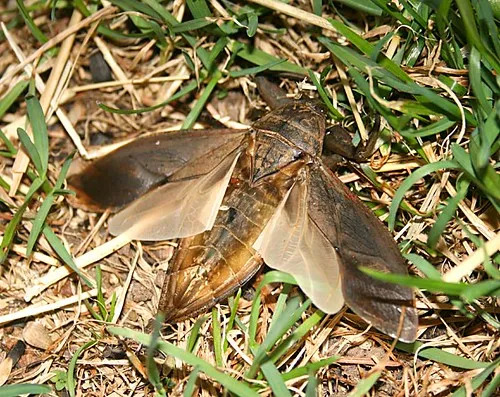
(Image: a giant water bug with its wings extended, standing on grass. End ID)
#wet beast wednesday#aquatic insects#water bug#giant water bug#water scorpion#creeping water bug#backswimmer#water boatman#water boatmen#toad bug#velvety shore bug#true bugs#hemiptera#insects#bug#bugs#bugblr#invertebrates#invertiblr#arthropods#freshwater ecology#biology#ecology#zoology#entomology#educational#informative#image described
92 notes
·
View notes
Text

giant waterbeetle aka the toe biter. I actually had one of these bite my toe while I was swimming as a kid
made in 2025
#giant water bug#bug art#linocut#linocut print#linoprint#block printed#block printing#block print#animal art#nature art#printmaker#printmaking#traditional printmaking#traditional printing#artists on tumblr#lesbian artist#butch artist#trans artist#traditional art#small artist#linocarving#original art#disabled artist#linogravure#art#bugblr
62 notes
·
View notes
Text

one of my favorite bugs, belostomatidae! also known as the giant water bug or toe biter ★彡
i did a bad job at cleaning up the paper but eh that’s alright
65 notes
·
View notes
Text

Enough said
#invertebrates#aquatic entomology#aquatic biology#bugs#tw bugs#belostomatidae#family: belostomatidae#giant water bug#icthyology#entomology art#entomology#aquatics
109 notes
·
View notes
Text



Giant water bug bag from thequirkyzipper on tiktok!
#stimboard#moodboard#stim#fake bugs#bugs#giant water bug#bag#shoulder bag#visual stim#irl people#black#brown#orange#bug#clear#shiny#wings#tactile stim#hands
215 notes
·
View notes
Text

Toe-Biter aka American Giant Water Bug (Lethocerus americanus), family Belostomatidae, ONT, Canada
President Joe Biden put this weird bug in charge of the night time.
They have a painful "bite". They actually have a piercing mouth part. They are not usually aggressive, but will pierce you in defense.
This is a large aquatic insect, growing to a body length of up to 6 cm (2.4 inches).
photograph by Steph Shotton
#water bug#giant water bug#bug#lethocerus#belostomatidae#insect#hemiptera#entomology#animals#nature#north america
624 notes
·
View notes
Text

Giant Water Bug
Frank Vassen / Flickr / CC BY 2.0
49 notes
·
View notes
Text

Another playmat design for a fellow magic the gathering player! This one based off of the weird bug in charge of the night time. Used a lot of new texture brushes for this one and had a blast. My comms are open!

65 notes
·
View notes
Text

Scrapped pokémon concept art, featuring a line based on a diving beetle that evolves into a giant water bug.
#pokemon#pokemon leaks#pokemon teraleaks#gen 6 pokemon#kalos#pokemon x and y#water beetle#giant water bug#now this had me pissed#i saw the huge tail and knew this was a toe biter#i was pissed the most for this because how am i to live without it now#the toe biter wouldve been on my team
69 notes
·
View notes
Note
Do you have a favorite bug? Or favorite family of bugs?
I do!! It is really hard for me to choose as I love so many bugs. Runner ups include centipedes, moths (especially luna and cecopria) and millipedes. Specific honorable mentions are acorn weevils, green june beetles and Asian praying mantises... I also like many many native bugs in my area and favor beetles.
But the true star of the show is...

The giant water bug!!! I just think they're so cool and cute and very misunderstood. They have a bad reputation since they can deliver a painful bite, but can also be docile and handled if treated with respect and care. They're beautiful true bugs (literally!) and just so important to me. I find them graceful and wonderful despite a common hatred for them.
I have a tattoo of these guys and made an art piece using pinned ones as a gift for my wife, called The Proposal. I'll have that one under read more in case you don't want to see pinned bugs.


#bugblr#bugs#entomology#bughearted#bugkin#bug tattoo#giant water bug#water bug#insect pinning#bug pinning#bug art
43 notes
·
View notes
Text




"The Proposal"
My second insect pinning piece using giant water bugs this time. This was a piece made for my wife, using the flower I tucked into her hair the night I proposed to her. This piece is meant to emulate a proposal in much the same way. :)
I am very proud of how it came out!!!
#visual poetry#t4t#trans4trans#t4t romance#qpr#qpr marriage#transmasc#trans#trans man#bugblr#entomology#bugs#giant water bug#giant water bugs#water bugs#insect pinning#bug pinning#bug art#insect art#taxidermy
33 notes
·
View notes
Text






Happy water bug Wednesday!
I’m just a little bit obsessed with their little raptor arms not gonna lie. Belostomatids, known as giant water bugs and also as toe biters, are in full baby season where I am right now, meaning I can finally hold some tiny ones without suffering their worst bites!
The adults tend to bite the absolute shit out of me when they get the upper hand. I am very fond of them all the same. Pretty common bug here. Very quick to scramble off your hand and very quick to bite you if they can’t figure that out fast enough.
#aquatic insects#insects#entomology#bugs#nature#science#my photos#hemiptera#true bugs#belostomatidae#giant water bug#toe biter#water bug wednesday
60 notes
·
View notes
Text
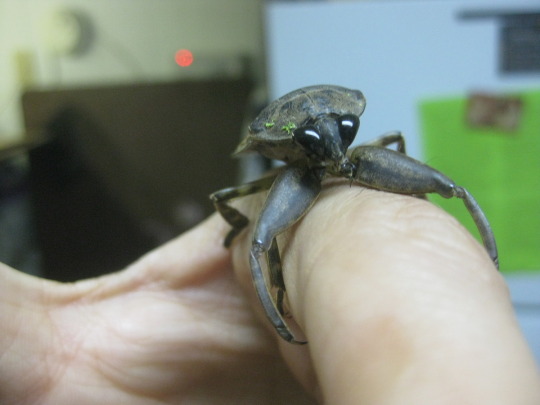
17 notes
·
View notes